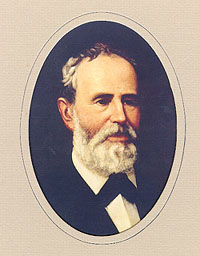Elisha Marshall Pease, Texas’s 5th and 13th governor and public servant, was born to Lorrain Thompson and Sarah (Marshall) Pease on January 3, 1812, at Enfield, Connecticut. After attending Westfield Academy in Massachusetts, he clerked in a general store and then in a post office. In 1835, Pease settled in Texas in the Municipality of Mina (Bastrop). On October 2, he fought in the battle of Gonzales, the first battle of the Texas Revolution. He served as secretary to the General Council of the Provisional Government and in March 1836, attended the convention at Washington-on-the-Brazos, in which Texas declared its independence from Mexico. Pease helped write part of the Constitution of the Republic of Texas and served in the ad interim government first as chief clerk of the navy and then as chief clerk of the treasury department. Pease served as clerk of the judicial committee of the House of Representatives and was comptroller of public accounts in 1837.
After Texas’s annexation to the U.S., Pease served in the first three legislatures as the representative from Brazoria County and authored the Probate Code of 1846. He made an unsuccessful bid for governor in 1851, ran again two years later and won the office, and was reelected in 1855. While in office, Pease pioneered the effort to establish a system of public education and a state university. His administration established the permanent school fund. Pease encouraged railroad construction in Texas, as well as efforts to make the state penitentiary self-supporting. He also worked to establish reservations and educate the state’s Indian population.
Pease supervised the fund-raising campaign to complete the Governor’s Mansion, the General Land Office building, the State Orphan’s Home (now the Corsicana State Home), and a new Capitol building. Probably the most significant of Pease’s achievements was the settlement of the state’s public debts. This made funds available for the establishment of a hospital for the mentally ill and schools for the deaf and blind (Austin State Hospital, Texas School for the Deaf, Texas School for the Blind), all of which he recommended to the legislature. The state was in excellent financial position when Pease retired from office in 1857.
Pease supported the Union faction in Texas politics during the Civil War, and quietly remained loyal to the Union. He helped organize the Republican Party in Texas in 1867. Later that year the incumbent governor, James W. Throckmorton, was removed from office and Pease was appointed in his place. Because of differences over Reconstruction policies, he resigned from the governorship in 1869. Pease was president of the Taxpayers’ Convention of 1871, and in 1872, served as chairman of the Texas delegation to the national Liberal Republican Convention. In 1879, President Rutherford B. Hayes chose him to be collector of customs in Galveston. Afterwards, Pease spent his remaining years practicing law in Austin and involved in various business ventures.
In 1850, Pease married Lucadia Christiana Niles of Poquonock, Connecticut. They had three daughters, but one died in childhood. After an attack of apoplexy, Pease died on August 26, 1883. He was buried in Oakwood Cemetery in Austin.
Pease Street in Houston is named in Elisha Marshall Pease’s honor. Pease Street runs southeast to northwest and is near Stephen F. Austin High School in southeast Houston.


